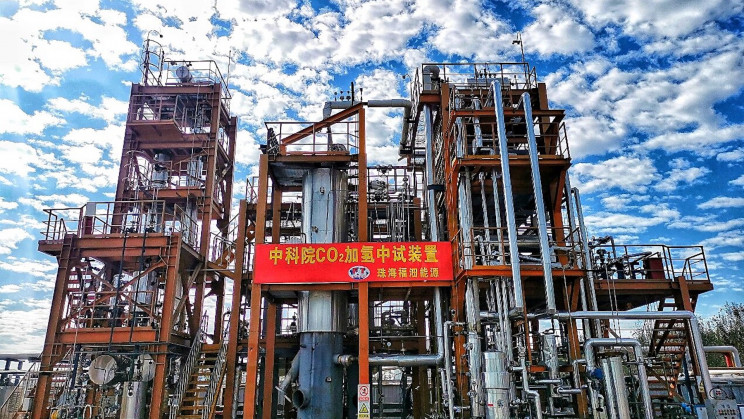The world-first facility, which was developed by the Dalian Insitute of Chemical Physics (DICP) and Zhuhai Futian Energy Technology, hydrogenates carbon dioxide into green fuels, which could help to reduce the amount of carbon dioxide in the atmosphere.
A facility that will produce 1,000 tons of gasoline per year out of carbon dioxide has successfully completed its trial operation as well as a technology assessment on March 4, a press statement reveals.
In its statement, the DICP says “a technology that can selectively produce value-added hydrocarbon fuels with high energy density will provide a new route for promoting clean and low-carbon energy revolution.”
Carbon dioxide hydrogenation technology for producing gasoline was originally proposed by DICP’s Sun Jian GE Qingjie and WEI Jian in a 2017 paper published in the journal Nature Communications. The method uses metal catalysts to convert carbon dioxide into biofuels that are less harmful to the environment.
Producing green fuel from CO2
The demonstration facility was completed in Zoucheng Industrial Park, in 2020. In October 2021, it passed a 72-hour on-site assessment organized by China Petroleum and Chemical Industry Federation (CPCIF). During the assessment, it carried out carbon dioxide and hydrogen conversion with a 95 percent success rate, as well as gasoline selectivity with a rate of 85 percent.
The facility produced green gasoline with an octane number higher than 90 — which meets China’s national VI standard — and the scientists said it consumed little electricity as it converted the gases into fuel. “This technology marks a new stage of CO2 resource utilization technology in the world, and provides a new strategy for realizing the goal of [going] carbon-neutral,” said Prof. Sun.
In January, RMIT University researchers in Australia announced they developed a method to instantaneously turn CO2 into solid carbon. Though carbon capture technology does have the potential to help global carbon neutrality efforts, some scientists have warned that it can also serve as a “dangerous distraction” that could delay the transition away from fossil fuel consumption. Still, new technologies such as the DICP’s carbon dioxide hydrogenation device could be used in conjunction with other carbon capture technologies to greatly reduce carbon emissions.
Source: Interesting Engineering
Tags: CO2 Emissions, DICP, Green fuels, Hydrogenating, ZFET



Recent Posts
Report Highlights Pathway for Electrifying Nigeria’s Container Trade Sector
South Korean Company YPP Plans to Invest up to $3.1 Billion in Green Hydrogen Production in Kazakhstan
WattEV Expands Electric Truck Charging Network with Three New Depots in California
Anemoi Develops New Method to Accurately Measure Wind-Assisted Propulsion Benefits
Navigator Holdings and Amon Maritime Form Joint Venture for Ammonia-Fuelled Carrier Fleet
Hygenco Commissions Maharashtra’s First Green Hydrogen and Oxygen Facility to Power STL’s Net Zero Goals
India Invites Second Round of R&D Proposals Under ₹4 Billion Green Hydrogen Mission
BMTC Adds 148 Tata Electric Buses to Bengaluru Fleet, Strengthens Green Mobility Drive